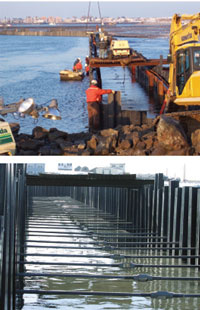Composite Sheet Pilings Alter Course of Erosion
 Seabrook Harbor has over 400 years of maritime history and function along the New Hampshire Atlantic coastline. Over time the harbor’s economic benefits were slowly being hindered due to erosion and risks associated with increased silt levels from the Blackwater River.
Seabrook Harbor has over 400 years of maritime history and function along the New Hampshire Atlantic coastline. Over time the harbor’s economic benefits were slowly being hindered due to erosion and risks associated with increased silt levels from the Blackwater River.
The U.S. Army Corps of Engineers and the National Shore-Line Erosion Control Development and Demonstration Program arrived at a solution which would repair the breach between the shore and sand flats. Water from the river had to be diverted from the town utilizing a cofferdam-like structure on the north side of the harbor, while river dredging and dredge spoils also had to be implemented.
The walls of the structure were anchored with a galvanized steel tie-back system with 18” rods and connecting turnbuckles on 6’ centers and two 10” channels. UltraComposite™ UC 30 sheet piling was driven 15’ - 20’ into the ground to protect against potential scour.
To drive the UltraComposite™ UC 30 sheets, Reed & Reed Construction used an ICE 216 vibratory hammer hanging from a crane. 160 sheets or 240 feet of bulkhead were completed daily.
UltraComposite™ 17’ and 27’ sheet piling was chosen in the place of steel because hydro- dynamic models were built to measure theoretical solutions and calculations.
UltraComposite™ UC 30 is the only composite sheeting manufactured in a Strongwell ISO-Certified facility. With service and monitoring, the project has reclaimed clam flats, reintroduced recreational activities, fishing and diverted the river to its previous course. The walls, which by design are completely submerged during high-tide, have put an end to the shoreline erosion and periodic flooding of the town. In addition, the harbor is only scheduled to be dredged every five years instead of yearly translating into reduced spending on behalf of the state and municipality.
Click here to view the entire case study.